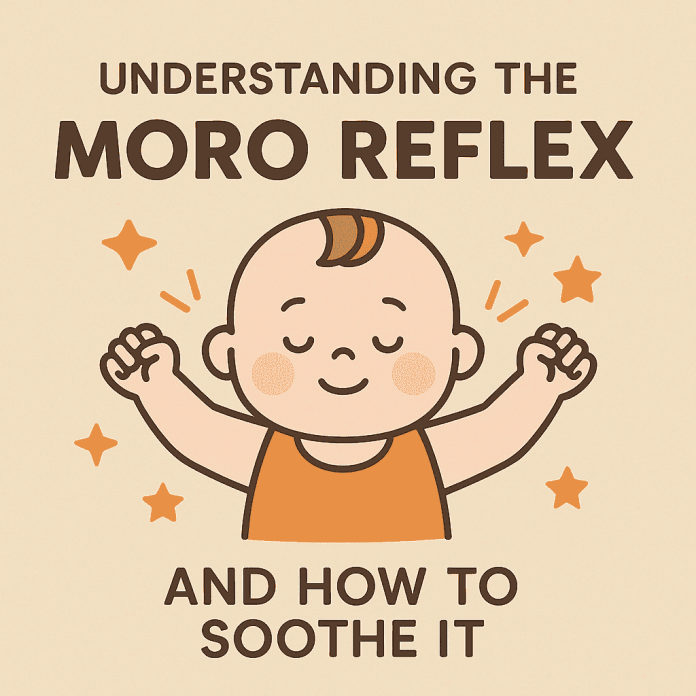Introduction
If your newborn suddenly flings their arms out, opens their hands, then pulls their arms back in and cries, you’re seeing the Moro reflex—also called the startle reflex. This primitive reflex is normal and temporary, but it can interrupt naps and nights. Understanding what triggers it and learning gentle ways to respond helps you create a calmer sleep environment. For a deeper dive on wrapping techniques that tame startle movements, see our related guide:
Why Your Baby Needs a Swaddle.
- Who: Newborns and young infants with developing nervous systems.
- What: An involuntary startle reaction to sudden change (movement, sound, light).
- When: Most noticeable from birth to ~4 months; fades by ~6 months.
- Why: A protective neurological response; a sign of healthy development.
- How: Soothe with swaddling, slow transitions, white noise, and skin-to-skin.
What Is the Moro Reflex?
The Moro reflex is an automatic, symmetrical movement pattern present at birth. When triggered, baby briefly feels a falling sensation: arms extend and hands open, then arms flex back toward the chest, often followed by a cry. It’s a built-in survival response that gradually integrates as motor control matures.
Why Does It Happen?
Outside the womb, babies experience gravity, open space, and unpredictable inputs for the first time. Their nervous systems are still tuning sensors for balance, sound, and light. Sudden noise, quick position changes, or loss of head support can signal “something changed fast,” triggering the startle reflex.
- Sudden sound (door slam, barking, clatter)
- Quick changes in light or temperature
- Rapid lowering into the crib without head support
- Unexpected touch or jostling
When It Starts and Stops
| Age Window | Reflex Pattern | Parental Expectation |
|---|---|---|
| 0–2 months | Strong, frequent startles | Common night wakings; rely on soothing routines |
| 2–4 months | Gradual reduction | More consolidated sleep with support |
| 5–6 months | Integration/fading | Reflex largely gone in typical development |
How to Recognize It
Look for a sudden outward fling of both arms with open hands, followed by a quick inward hug-like motion, a startled face, and sometimes a cry. It appears most often during transfers to the crib, in light sleep, or after sharp noises.
Moro Reflex & Baby Sleep
Startle jerks can pop a baby from light sleep into full wakefulness. Minimizing sudden inputs and gently containing arm movements can reduce awakenings. That’s why many families use swaddling in the early months: it provides even pressure that dampens flailing while keeping hips free.
How to Soothe the Moro Reflex
The goal isn’t to “stop” this healthy reflex but to soothe its effects. Combine environmental tweaks, gentle handling, and consistent cues so baby’s nervous system associates sleep with calm and safety.
- Swaddle correctly: breathable fabric; snug at chest, hips free; discontinue once rolling signs appear.
- Slow transitions: lower baby gradually with head and neck supported.
- Sound shaping: steady white noise to mask sudden spikes.
- Skin-to-skin: regulates temperature and heart rate; reduces startle intensity.
- Rhythm: rocking, babywearing, or gentle chest pats to re-settle after a startle.
Safe Soothing Techniques (with Examples)
| Situation | Gentle Response | Why It Helps |
|---|---|---|
| Startle mid-nap | Hand on chest + soft “shh” | Stability cue reduces arousal |
| Laying down to crib | Lower slowly; feet-to-mattress first | Prevents falling sensation |
| Noise-triggered wake | White noise; dim light; brief cuddle | Masks spikes; re-assures quickly |
| Evening cluster fuss | Swaddle + sway or babywear | Even pressure + rhythmic motion |
Comparison Tables
Normal vs. Persistent Reflex
| Type | Description | Age | Action |
|---|---|---|---|
| Normal | Symmetrical startle; quickly settles | Birth–4 months | Use soothing techniques as needed |
| Persistent | Strong or one-sided after 6 months | > 6 months | Consult pediatrician |
| Absent | No startle in newborn period | Birth | Medical evaluation recommended |
Trigger Intensity Levels
| Level | Common Triggers | Impact | What Helps |
|---|---|---|---|
| Low | Soft sounds, dim changes | Brief stir; self-settles | White noise; consistent routine |
| Normal | Door slams, quicker transfers | Occasional wakes | Swaddle, slow lowering, hand on chest |
| High | Loud bangs, bright flashes | Frequent wakes, crying | Soundproofing habits, darker room, contact soothing |
When to Talk to Your Pediatrician
- Reflex persists strongly beyond 6 months.
- Appears only on one side (asymmetry).
- Absent from birth or baby seems unusually stiff/limp.
- Concerns about feeding, growth, or development alongside startles.
Conclusion
The Moro reflex is a healthy sign of a developing nervous system. While it can disrupt sleep, simple, evidence-informed strategies—swaddling, slow transitions, white noise, and skin-to-skin—help your baby feel secure until the reflex fades naturally between four and six months. For step-by-step wrapping tips, visit our guide:
Why Your Baby Needs a Swaddle.

